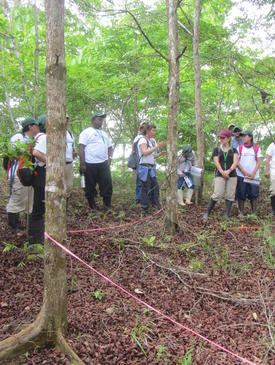Forest Restoration Strategies in Agricultural Landscapes of Panama
Summary
The Republic of Panama is known worldwide for providing a critical link in global trade via the Panama Canal and its impressive economic growth and first-world city skylines. Nevertheless, in Panama is a developing country of stark economic inequalities. The World Bank estimates poverty in rural Panama at 60%, commonly lacking public services, access to education and economic opportunities. Many rural people in Panama live agrarian livelihoods that focus on subsistence agriculture and small-holder cattle ranching. These conventional practices involve the cutting and burning of forests to plant annual crops and pasture grasses. As a result of such practices, the country lost over 30% of its forest cover from 1950 to 2000. While Panama's deforestation rates have slowed in the past 15 years due to increased enforcement of environmental laws and regeneration of forests in abandoned agricultural lands, Panama's ecosystem services continue to be degraded by unsustainable land use practices and the lack of knowledge regarding sustainable agricultural systems and reforestation efforts with native species. As a result, the FAO (2014) estimates that 27% of Panama's agricultural lands are dry and degraded.
As a means of providing support for the marginalized people of developing countries like Panama, the United States Peace Corps sends professionals to “serve as Peace Corps Volunteers (PCV), who work at the grassroots level toward sustainable change that lives on long after their service.” Volunteers are assigned for two years to communities that request Peace Corps' assistance. The development assistance that PCVs provide in their communities is critical to improve the capacity of local people.
As a means of giving further technical training to PCVs in their role as trainers, ELTI will deliver a “training of trainers” course that provides the practical understanding necessary to guide forest restoration strategies with their community counterparts to facilitate effective forest restoration and sustainable management in agricultural landscapes. This two day field-course will be facilitated as part of the Peace Corps Panama's week-long “In-Service Training,” which is offered to PCVs after serving three months in-site and completing their community analysis.
Content
The material is divided into thematic modules, which each include an introductory lecture and reinforced by field-based observations and group exercises and analysis.
Module 1: Forest ecology and the provision and regulation of ecosystem services
• Introduction to tropical forests ecosystems of Central America
• The provision and regulation of ecosystem goods and services
• Introduction to tropical forest dynamics
Module 2: Deforestation and forest degradation
• Introduction to regional and international drivers of tropical forest deforestation and degradation
• Ecological and social consequences of degradation and barriers to restoration
Module 3: Strategies for the restoration of ecosystem services in human-modified landscapes
• Importance of defining management goals and accounting for biophysical site conditions
• Tailoring restoration strategies to the socioeconomic and cultural contexts
• Principles and methods of forest restoration and the range of passive to active restoration strategies
• Propagation of native tree species
• Monitoring and evaluating restoration efforts


